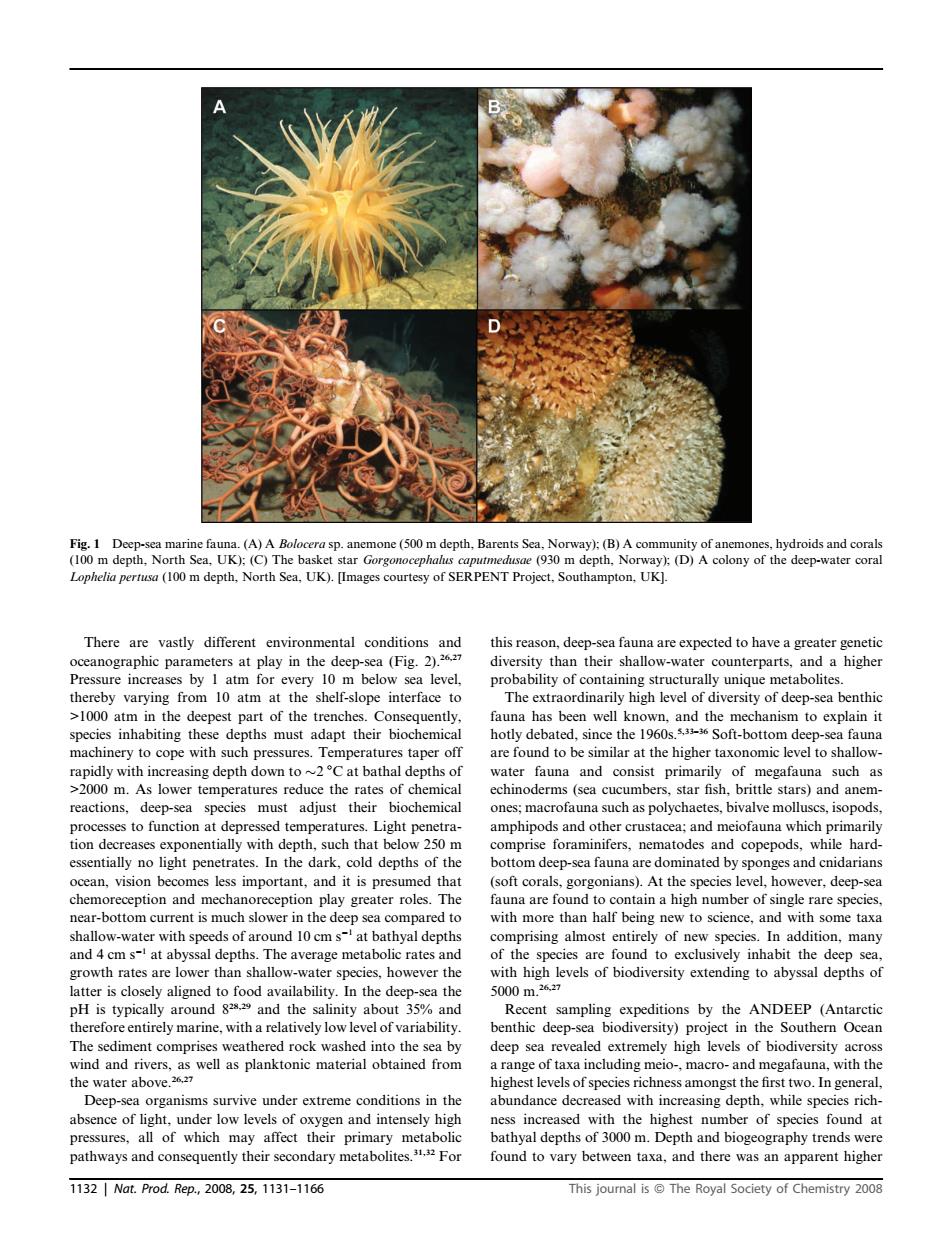正在加载图片...

amarine faun .(A)A Bolocera sp.ane one (500 m depth.Barents Sea.No mones,hydroids and corals RO匹7Amps边 Ther g nental conditions his r sea faun play in the dee increases by 1 atm for m below sea level varying from 10 atm at the she o。 terfa The ext ordina diversity of dee species inhabiting these depths must adapt their biochemical are found to be similar at the higher taxonomic level to shallow at bath and con sist primarily duce the reactions.deep-sea species must adiust their biochemical eception and umber rare spe shallow-water with sne eds of around 10 cm sat bathval depths prising almost entirely of new species.In addition,many and 4cms-at abyssal depths.The average metabolic rates and of the e species are found to exclusively inhabit the deep sea ersity extending to abyssal depths o pH is typ oically around and the salinity abou 35%and Recent sampling expeditions by the ANDEEP (Antarctic herefore entirely marine.with a relatively low level of v benthic deep-sea biodiversity)project in the Southern Ocean ed and eep sea 09 the water above siy山hhe highe est levels of species ric chness amongst the first two.In general nce d th increasing depth.whil sp oressures.all of which may affect their primary metabolic bathval depths of 3000 m.Depth and biogeography trends were pathways and consequently their secondary metabolites.For found to vary between taxa.and there was an apparent higher 1132|Nat.Prod.Rep,.2008,25,1131-1166 This journal is e The Roval Society of Chemistry 2008 There are vastly different environmental conditions and oceanographic parameters at play in the deep-sea (Fig. 2).26,27 Pressure increases by 1 atm for every 10 m below sea level, thereby varying from 10 atm at the shelf-slope interface to >1000 atm in the deepest part of the trenches. Consequently, species inhabiting these depths must adapt their biochemical machinery to cope with such pressures. Temperatures taper off rapidly with increasing depth down to 2 C at bathal depths of >2000 m. As lower temperatures reduce the rates of chemical reactions, deep-sea species must adjust their biochemical processes to function at depressed temperatures. Light penetration decreases exponentially with depth, such that below 250 m essentially no light penetrates. In the dark, cold depths of the ocean, vision becomes less important, and it is presumed that chemoreception and mechanoreception play greater roles. The near-bottom current is much slower in the deep sea compared to shallow-water with speeds of around 10 cm s1 at bathyal depths and 4 cm s1 at abyssal depths. The average metabolic rates and growth rates are lower than shallow-water species, however the latter is closely aligned to food availability. In the deep-sea the pH is typically around 828,29 and the salinity about 35% and therefore entirely marine, with a relatively low level of variability. The sediment comprises weathered rock washed into the sea by wind and rivers, as well as planktonic material obtained from the water above.26,27 Deep-sea organisms survive under extreme conditions in the absence of light, under low levels of oxygen and intensely high pressures, all of which may affect their primary metabolic pathways and consequently their secondary metabolites.31,32 For this reason, deep-sea fauna are expected to have a greater genetic diversity than their shallow-water counterparts, and a higher probability of containing structurally unique metabolites. The extraordinarily high level of diversity of deep-sea benthic fauna has been well known, and the mechanism to explain it hotly debated, since the 1960s.5,33–36 Soft-bottom deep-sea fauna are found to be similar at the higher taxonomic level to shallowwater fauna and consist primarily of megafauna such as echinoderms (sea cucumbers, star fish, brittle stars) and anemones; macrofauna such as polychaetes, bivalve molluscs, isopods, amphipods and other crustacea; and meiofauna which primarily comprise foraminifers, nematodes and copepods, while hardbottom deep-sea fauna are dominated by sponges and cnidarians (soft corals, gorgonians). At the species level, however, deep-sea fauna are found to contain a high number of single rare species, with more than half being new to science, and with some taxa comprising almost entirely of new species. In addition, many of the species are found to exclusively inhabit the deep sea, with high levels of biodiversity extending to abyssal depths of 5000 m.26,27 Recent sampling expeditions by the ANDEEP (Antarctic benthic deep-sea biodiversity) project in the Southern Ocean deep sea revealed extremely high levels of biodiversity across a range of taxa including meio-, macro- and megafauna, with the highest levels of species richness amongst the first two. In general, abundance decreased with increasing depth, while species richness increased with the highest number of species found at bathyal depths of 3000 m. Depth and biogeography trends were found to vary between taxa, and there was an apparent higher Fig. 1 Deep-sea marine fauna. (A) A Bolocera sp. anemone (500 m depth, Barents Sea, Norway); (B) A community of anemones, hydroids and corals (100 m depth, North Sea, UK); (C) The basket star Gorgonocephalus caputmedusae (930 m depth, Norway); (D) A colony of the deep-water coral Lophelia pertusa (100 m depth, North Sea, UK). [Images courtesy of SERPENT Project, Southampton, UK]. 1132 | Nat. Prod. Rep., 2008, 25, 1131–1166 This journal is ª The Royal Society of Chemistry 2008���